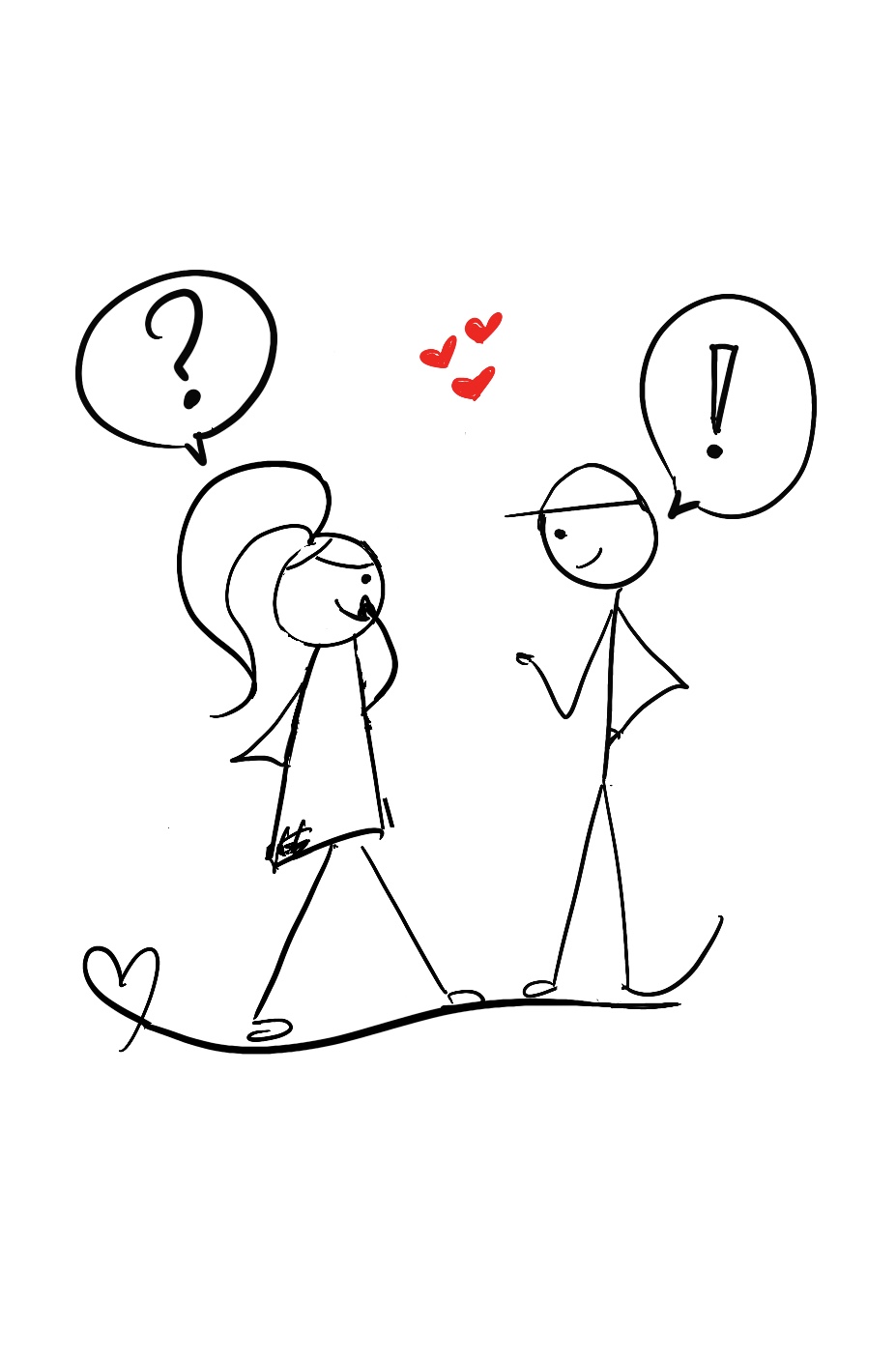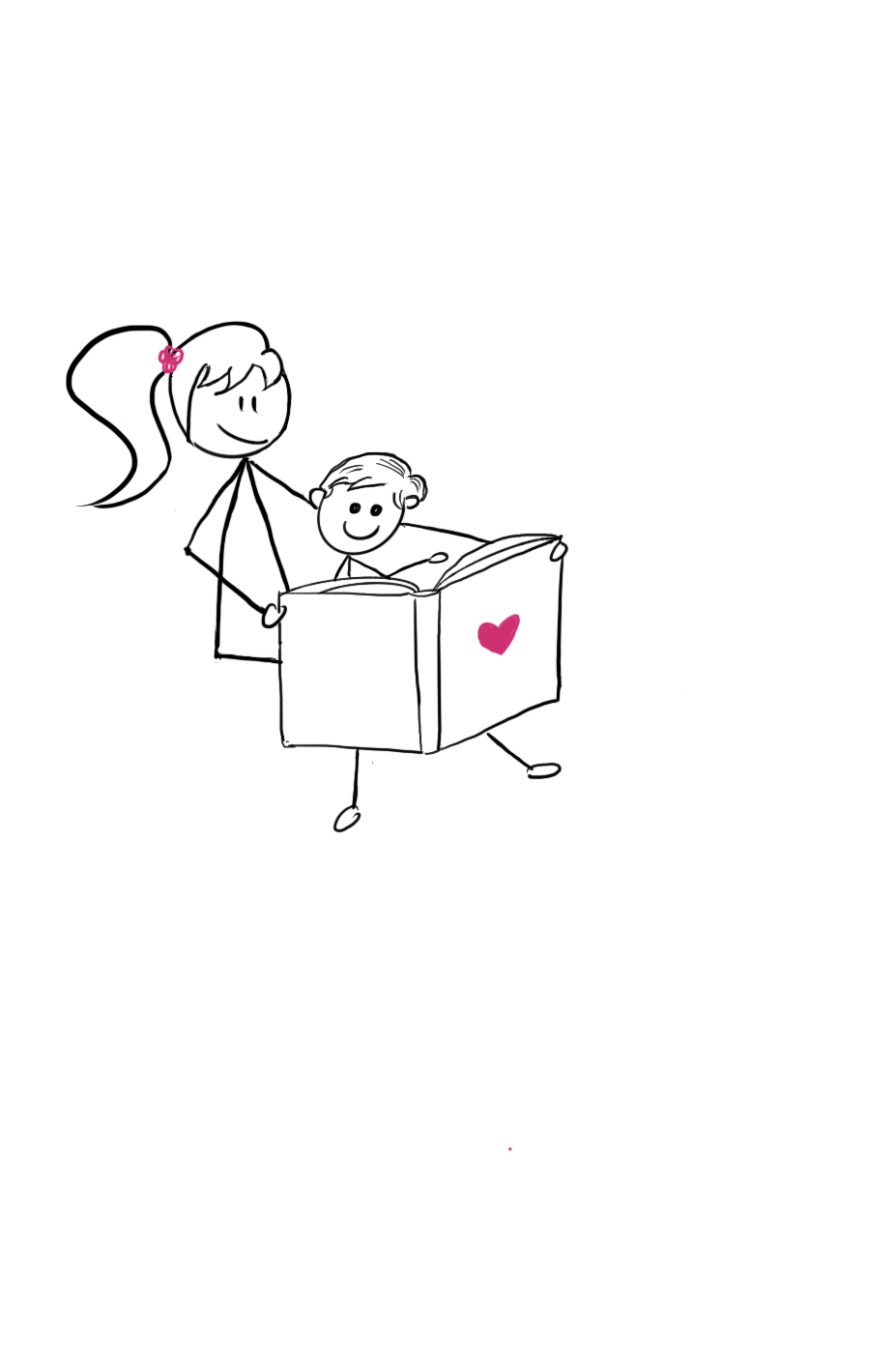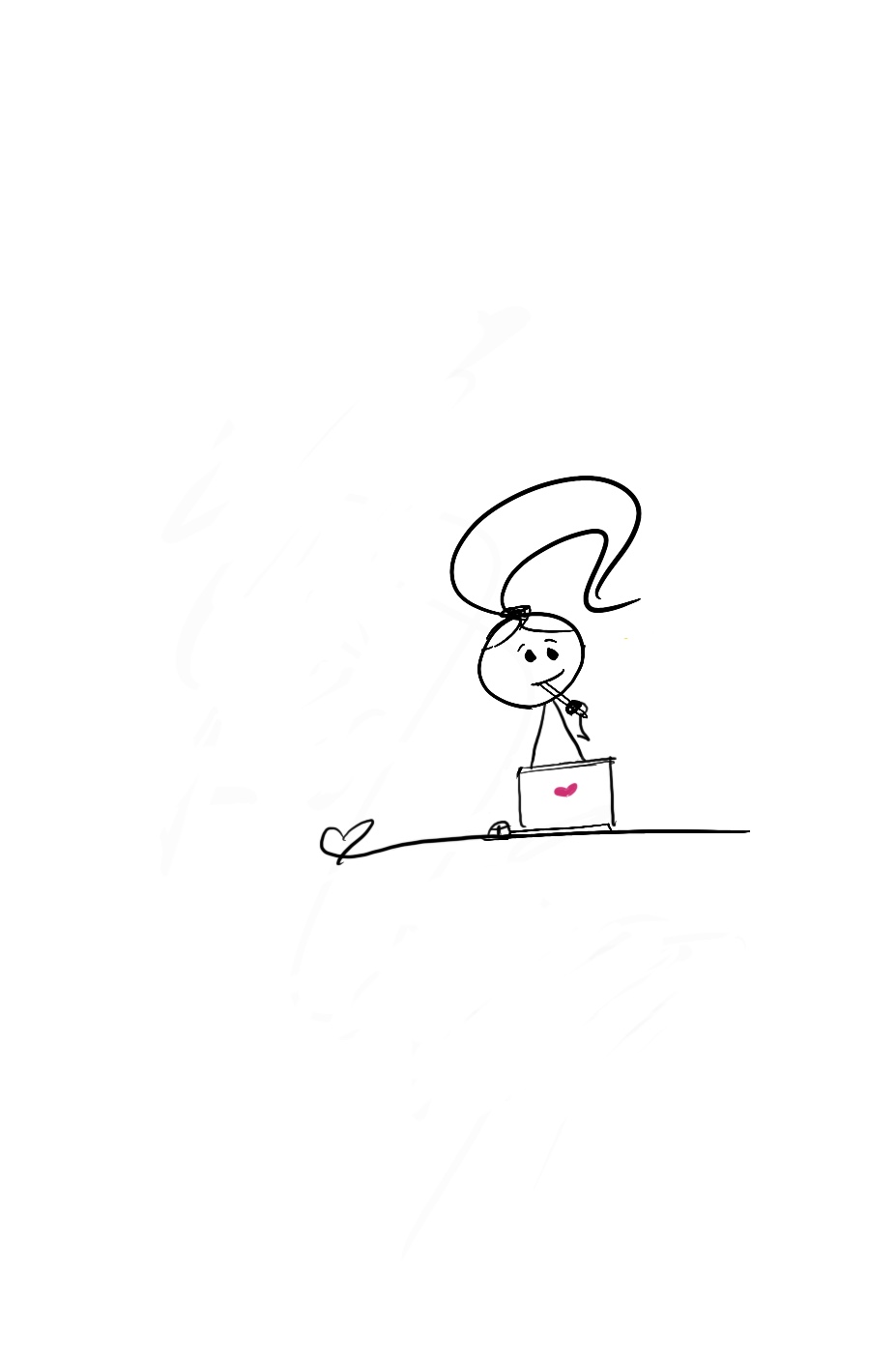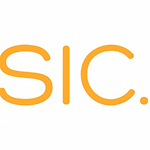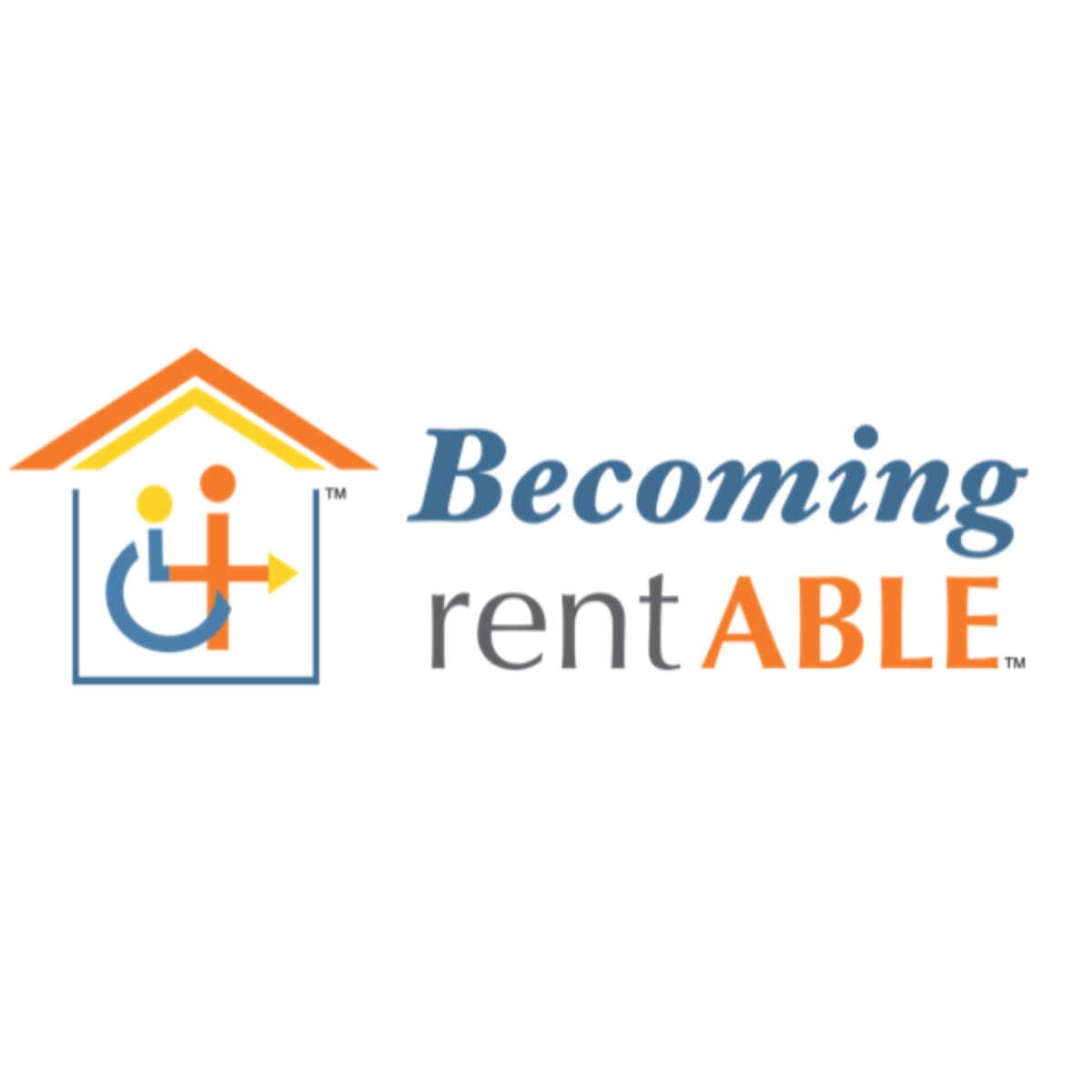5 Expert Mental Health Tips for Children With Cerebral Palsy
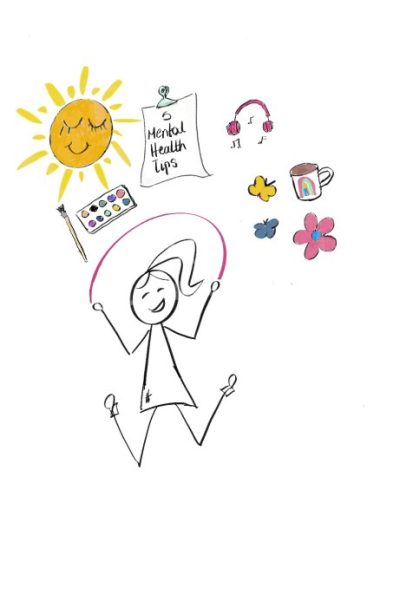
You knew this day would come.
You just didn’t think it would be so soon.
And now, you’re facing something that often gets overlooked. Sometimes, even ignored by doctors, teachers, parents, and your own children.
Mental health.
So, how do you empower mental health for your child with Cerebral Palsy?
I spoke with experts and parents who’ve experienced this firsthand, and these are their top five mental health tips.
1. Encourage a bright future
The truth is, when you’re raising a child with Cerebral Palsy, it’s easy to picture a future that feels tough and full of limits.
Even parents shift the focus and try to manage behavior instead of helping children grow their independence.
And when expectations stay low, kids start to believe it too.
They feel like they’re not good enough before they even have a chance.
One example is Briane, a 32 year old woman with mild spastic diplegia who shared her experience:
“I'm 32 and I am just now working on driving because my family didn’t want to let me try driving to school. There was zero encouragement, only fear and anxiety that I would kill someone when they hadn't even taken me to an empty parking lot to test perception or anything."
So, when I did get behind the wheel I had panic attacks and full on melt downs.
Don’t let this be you.
A big part of your child's mental health comes down to how much they feel.
Encouraged. Supported. And, loved.
This makes all the difference in how they handle what life throws at them.
So go ahead, give your child as many opportunities to experience life to its fullest.
2. Team up with teachers for a custom learning strategy
Kids with Cerebral Palsy don’t just deal with challenges at home, they also miss a lot of school because of health issues.
And missing school can make it even harder to keep up with learning and staying involved.
Jeremy D. Finn, a psychologist and professor at SUNY, said:
“The way students connect and engage with their school environment, with their peers, and with materials, shapes how they experience school.”
In other words, it’s not just about wanting to participate.
Children thrive when they can choose how they want to be involved.
But for kids with Cerebral Palsy, gaining independence can be tricky.
Some kids are only a little affected, while others face bigger challenges.
That’s why it’s so important to get as much information as you can to build a plan that actually fits your child.
Is your child high tone or low tone? Are they walking independently, using a walker, or a wheelchair? Do they speak verbally, or use a communication device? Do they have a visual disability?
Work closely with their teachers and their therapy team and set the right goals for them.
In my experience as a teacher for students with visual impairements (TVI), progress isn’t just about grades or test scores.
It’s in the small, meaningful wins that build real independence, and empower mental health.
Like learning to use a communication device. Taking their first steps with adaptive gear. Or finding what activity lights them up inside.
Every milestone — every shaky first step, a new word spoken, or a spark of excitement while trying something new, reflects grit, creativity, and the power that comes from having the right people cheering them on.
So offer your child different ways to learn.
This might look like a combination of homeschooling and public school, or attending private school.
If you want to learn more about Individualised Educational Programs (IEPs) visit Kids Health.
Whatever path you take, build a foundation that feels steady, safe, and strong enough to lift their mental health and confidence as they grow.
3. Make Space for Fun, Growth, and Mental Health
I know the feeling.
Between managing daily life, worrying about mental health, and juggling school stuff, fun and downtime barely get noticed.
But the truth is, fun matters too.
Swimming, painting a messy picture, joining a soccer club, or just hanging out with friends — these moments build skills, boost mental and physical health, uncover hidden talents, and create real, lasting friendships.
When your child does what they love they can figure out who they are, how to take charge at home, at school, and in the community.
And, if you’re running out of ideas (or just feeling burnt out from trying to plan everything), helping your child start a hobby can take a huge load off.
Here are some examples that I love:
- Music and dancing (a great way for children to express themselves, connect with others, and have fun).
- Accessible sports like soccer, riding, and swimming (visit Move United).
- Gardening (can be done seated or standing, it helps improve mobility, concentration, and focus).
- Arts and crafts (hands-on activities that improve motor skills, increase focus and strengthen social connections).
- Video games (many games today have adaptive controllers and accessibility options).
Obviously this list isn’t extensive.
There are many more activities and hobbies that empower mental health.
So, go on.
Make space for hobbies and fun.
4. Encourage disabled and non-disabled relationships
Ever wondered if your child will be invited to birthday parties? Or chosen to sit with at the cafeteria at school?
I have.
When my son was diagnosed with epilepsy, these questions burned in my mind. And, they left me feeling desperate and frustrated.
Will his disability limit his social life? Will he miss the chance to create real, long-lasting connections?
Honestly, parents tend to get caught up in learning that they forget the magic of letting kids connect and learn about each other.
But children feel better when they’re actually part of social life, not just sitting in it.
For example, in my son’s class, there are 20 kids, and 9 of them have disabilities.
So here’s what we did (in and out of school) to make sure Niklaas could build real friendships:
- Planned activities that encouraged teamwork (like buddy programs).
- Talked openly about differences and abilities — normalize it, don’t make it a big, separate deal.
- Assigned mixed groups during activities to promote natural interactions.
- Assigned peer “buddies” who can help with academic and social participation — but avoided making one student feel like a “helper” and the other like a “project”.
- Created games and projects where diverse skills shine (art, building tasks, storytelling circles, gardening).
- Involved children with disabilities in visible ways in school and community projects.
At the end of the day, positive interaction with other children empowers mental health, but it doesn’t always happen on its own.
So put your mitts on and get involved in friendship building.
5. Nurture Social Emotional Learning (SEL)
A recent study from Yale found that children involved in Social Emotional Learning (SEL) showed a boost in emotional skills like self-confidence, resilience, and optimism.
Not only that, but they also experienced less anxiety, stress, and depression, and felt more connected and included at school.
Today, International SEL Day, gets its own day — happening every year on the second Friday of March.
One thing is for sure.
Social-emotional learning (SEL) empowers mental health for all kids — especially those children with cerebral palsy.
But how?
Let me show you.
- Identify emotions (drawing, acting them out)
- Use role-playing games to teach coping strategies (practice asking for help, and conflict resolution).
- Praise emotional efforts as much as academic ones ("You showed great patience today when the game rules changed.”).
- Volunteer or donate (children will learn to understand and connect with people from all sorts of backgrounds).
- Relieve stress (help your child recognize when they’re upset, help them build self-awareness, and manage emotions with mindfulness, exercise, or music).
Now it’s your turn.
You have the power to enhance mental health, improve social-emotional skills, and foster a supportive learning environment for your child.
Lead with honesty, support, and big love
It’s true.
People treat children with cerebral palsy differently, and sometimes less than.
Your child will have to work harder than anyone else because this is what it still means to be disabled in our world.
So remember: while your worries are real, your fears and anxieties are your own.
Your role as a parent, is to teach your child how to handle big feelings, how to communicate and work through them, in a healthy and positive way.
When you do this, you’ll empower your child’s mental health naturally.
So, all you can ever do is be honest, be supportive, and give your child as many opportunities to experience life to its fullest.
Subscribe to Disability Tidbits newsletter
Get expert insights and practical tips that help you reach a wider audience—the disability community.
Subscribe to Disability Tidbits newsletter
Get expert insights and practical tips that help you reach a wider audience—the disability community.
-
Disability Inclusive Language: Your Essential Beginners Guide
Have you ever felt awkward when you met a disabled person? Have you ever wondered how you should react? What should you say? We’ve all been there. Now, there are many enlightening pieces of advice out there showing you ‘what to do’. The downside? Most come in the form of a poster. They can educate…
-
5 Expert Mental Health Tips for Children With Cerebral Palsy
You knew this day would come. You just didn’t think it would be so soon. And now, you’re facing something that often gets overlooked. Sometimes, even ignored by doctors, teachers, parents, and your own children. Mental health. So, how do you empower mental health for your child with Cerebral Palsy? I spoke with experts and…
-
Scary Seizures And The Zigzagging Journey to Understanding Neurodivergence (Our Story)
The first quiet flickers of autism appeared when Niklaas was two. Not loud or alarming, but steady and sure, like the way dusk slips into a room. We’d crouch on the sun-warmed floor of his bedroom, lining up his tiny toy cars with the precision of a watchmaker: red firetruck next to cherry red dump…
Scary Seizures And The Zigzagging Journey to Understanding Neurodivergence (Our Story)
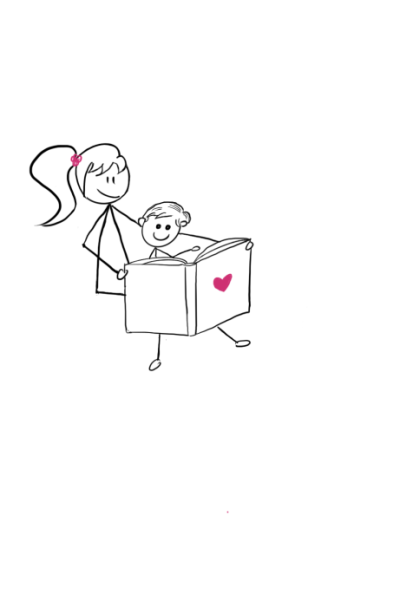
The first quiet flickers of autism appeared when Niklaas was two.
Not loud or alarming, but steady and sure, like the way dusk slips into a room.
We’d crouch on the sun-warmed floor of his bedroom, lining up his tiny toy cars with the precision of a watchmaker: red firetruck next to cherry red dump truck, lemony yellow Beetle beside mustard delivery truck, each one placed just so.
A soft hum would escape his lips as tires slid across the winding roads of his village play mat. We’d drive them in loops — never too fast, never off track.
The edge of the mat was the border. No car ever crossed it, no matter how wild the story we imagined. That was the rule. And in that rule, he found his rhythm.
Sometimes, he'd repeat words and phrases like little echoes, and flick his fingers in quiet moments.
Many times, he wouldn’t respond to his name, and if there was a sudden loud noise, he’d cover his ears and try to hide. Under a table, behind a chair, wherever it was quiet.
But unlike other autistic children I used to teach, Niklaas loved hugs. Craved them. He'd wrap himself around me like a koala and wouldn't let go.
In kindergarten, he was called “shy,” “sweet,” and “a little fearful.”
But I knew it was more than that.
I tried talking to people. Teachers, doctors, even my own family.
But no one seemed ready to listen—or maybe they just didn’t want to.
Because let's face it, it’s easier to believe a child is simply sensitive than to face the unknown.
Still, Autism runs in my husband’s side of the family. His cousins were diagnosed with Asperger's years ago, back when the term was still used. And well, my husband has "traits" as Niklaas's doctor says, but no official diagnosis.
Then came second grade.
That’s when everything went downhill, hard and fast. And, I noticed something new.
Niklaas’s head would bob sharply while eating breakfast. His hands would shake when holding a spoon, or while trying to write.
People said it was just early morning jitters. Even our paediatrician, who specialised in neurology, couldn’t see anything unusual at first.
By the 3rd grade, his symptoms escalated.
He’d come home from school looking completely drained. His face drooped. His eyes sagged. He had headaches that stopped him in his tracks.
Then, one day, his iPad dropped straight from his hands.
"My hands just let go," he whispered.
And, as he walked down the stairs, his knees buckled. That was it—I knew something wasn’t right.
I called the doctor and demanded an EEG at the Children’s Hospital in Basel.
And that’s when the graph lit up with answers.
Niklaas was experiencing constant electrical storms in his little brain. Hundreds of mini seizures in just half an hour. They were Myoclonic seizures.
But how? Where do they come from?
Our doctor explained, how seizures can be triggered by multiple factors, and often things parents never want think of.
It could be an infection, low blood sodium levels, medications (even drug use like amphetamines or cocaine, but that didn't apply.)
It could be something as serious as a brain injury or a tumour.
Sometimes, the cause remains a mystery, hidden deep in the brain's complex wiring.
And, it can feel like looking for a needle in a haystack, but the needle never shows up at all.
We started treatment that very day. And by the end of the week, his symptoms began to disappear.
It was like watching him come back to life.
Less than a month in, Niklaas was giggling again. Running. Playing. Laughing. Being his beautiful vibrant self.
Our relief was indescribable.
My husband and I had been running on autopilot for so long, just surviving the unknown. But now, with a name and a treatment plan, we could finally breathe.
But, that diagnosis was just the start of a much bigger story.
At the hospital, the doctors explained that their epilepsy diagnosis policy includes a full psychological evaluation.
That’s when we heard the word "comorbidities" for the first time.
The chief neurologist explained it like this:
“Children with epilepsy often experience cognitive and behavioural challenges, frequently linked to underlying neurodevelopmental conditions such as Autism, ADHD, or learning disorders. We’re finding more and more evidence of overlapping genetics.”
And just like that, the puzzle pieces started coming together.
By the 4th grade, Niklaas had additional diagnoses: Autism, ADHD, and Dyslexia.
That might sound like a lot. It is a lot.
But when we sat down and tried to explain, his response was simple.
"I feel like me, mommy."
And, isn’t that the whole point?
Because he is still our funny, clever, curious, affectionate boy. He’s still Niklaas.
Yes, these labels help us understand him better. They give us tools, language, and support.
But they don’t change who he is at his core.
Our journey has been full of hurdles, heartache, and sleepless nights.
But it’s also been filled with fierce love, quiet victories, and a deep gratitude for every moment we get to spend walking beside him.
And through it all, the one thing that matters most is his happiness.
That, and knowing — just like he says — that he’s always himself.
And what a beautiful self that is.
Subscribe to Disability Tidbits newsletter
Get expert insights and practical tips that help you reach a wider audience—the disability community.
Subscribe to Disability Tidbits newsletter
Get expert insights and practical tips that help you reach a wider audience—the disability community.
Alt text vs Image Descriptions (Understanding The Differences)

I bet you look at your social media posts and sigh.
You’ve just spent forever writing an engaging post.
Every word chosen with care, every sentence fine-tuned to shine. You’ve sprinkled your soul into it, and it shows.
But trying to decide between alt text and image descriptions can be tricky, right?
What’s the difference between alt text and image descriptions?
And, which one should you choose?
Let’s take a look at 3 key differences.
But first, let’s talk about why alt text and image descriptions matter.
Assistive technology (A brief intro)
People with visual disabilities use assistive tools and programs (like screen readers, magnification, enlarging font size, and text-to-voice) to access your digital content.
This means they need clear, concise image summaries, and that’s where alt text and image descriptions come in.
They bring your visuals to life through words.
But that’s not all.
Alt text and image descriptions aren’t just helpful for accessibility, they’re useful for SEO too.
When Google (and other search engines) try to figure out what your images are showing, they read your descriptions, and this can help your page show up higher in search results.
So, taking a little extra time to write clear and detailed descriptions is definitely worth it.
But, what’s the difference between alt text and image descriptions?
And, which one should you use?
Let’s take a look.
Understanding the differences
People often mix up alt text and image descriptions, but they’re actually not the same thing.
In fact, they serve different purposes.
So here are 3 key differences to help you understand them more.
1. Location
Alt text is usually attached to image metadata or added in the “alt text” box.
Image descriptions are found in the content of a webpage, next to the image or as a visible caption. On social media platforms, they’re usually in the body of your post. For extended descriptions, you can share them in a text link.
2. Visibility
Alt text is usually only visible to screen readers, which read the alt text out loud or display it on a braille display.
Image descriptions can be read by people with vision disabilities using other assistive tech (like magnification, enlarging font size, and text to voice).
3. Length
Alt text is a short, clear description that captures the image’s content and purpose. It’s added to an image tag in HTML or through a platform’s alt text field.
Image descriptions while there’s no “ideal” length, clarity and completeness usually means, image descriptions are longer, with more visual details that give more information about your picture.
Here’s an example:
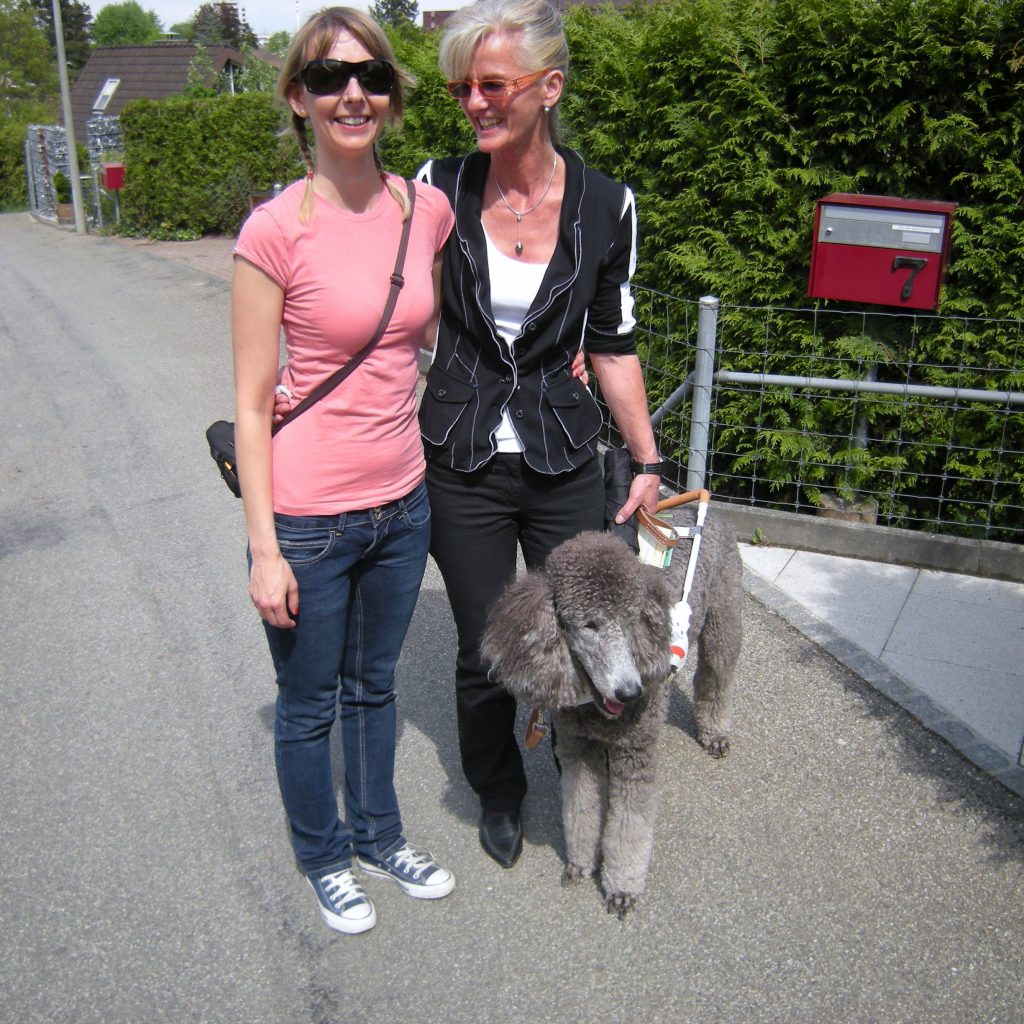
Alt text: Disability Writer, Lia Stoll, is standing next to her guide dog team.
Image description: Lia Stoll stands beside her blind client Yvonne and her guide dog Zorro, a beautiful, grey Giant Poodle. All three are beaming.
That’s it.
Now, you can practice what you learned and create accessible social media content that helps you reach a wider audience.
The secret ingredient to reaching a wider audience
Image descriptions and alt text open the door.
They make visual content accessible for people with visual disabilities.
They turn visuals into something everyone can engage with.
But, it’s not just about compliance and reaching a wider audience.
It’s about making sure everyone has equal access to your message, your story, and your business.
Subscribe to Disability Tidbits newsletter
Get expert insights and practical tips that help you reach a wider audience—the disability community.
Subscribe to Disability Tidbits newsletter
Get expert insights and practical tips that help you reach a wider audience—the disability community.
How To Create Image Descriptions (and Get Your Content Seen)

Let’s start with a little truth.
Writing image descriptions can be tricky.
There’s no perfect template, no hard-and-rigid rules.
In fact, it’s a creative, thoughtful process, and it’s wonderfully subjective.
Each image brings its own story, and you get to decide what part of that story is most important to tell.
So, when you're writing a description, think of yourself as the narrator, you're helping someone “see” through your words.
So, let’s break it down:
Here are 3 ways to help you get started, plus 10 tips to help you write image descriptions that are thoughtful, useful, and enjoyable to read.
Ready?
3 questions to get you started
Co-founder of Lara Guide Dog School, Anna Maria Gkertsou, shares 3 easy questions we can use to get started.
1. What’s the most meaningful part of the image?
Long image descriptions can get hard to follow when the main point is delayed or broken up.
Your description should reflect what really matters in the image and describe the information people need to understand your message, tone, or purpose behind your image.
2. What’s already included in the rest of your post?
If there’s important info already in your caption or body text, especially if your image includes text, you don’t need to repeat it in the image description.
Focus instead on what’s not visible in the written part of your content.
3. Is anything missing?
Once you’ve written everything, give it a final read.
Does it feel complete?
If something’s missing—some piece of context or a key detail—figure out where it belongs. Maybe it fits better in the caption, maybe it makes more sense in the image description.
Go ahead.
Use these questions to guide your thought process and create image descriptions that make your content accessible.
10 Friendly Tips for Writing Image Descriptions
Now you know what’s important in getting started, but how do you actually write an image description?
Here are 10 friendly tips to make image descriptions feel less intimidating and a little more human.
1. Keep it simple.
Use clear, plain language to describe what’s visually present. Think of it like describing a scene to a friend. Try not to overthink it, just say what you see, as accurately as you can.
2. Clarity over word count.
Descriptions don’t need to be long, they just need to be helpful. Some images call for a single line, while others (like graphics with a lot of text) might need a little more attention. Don’t worry about length, instead, aim for accuracy.
3. Skip phrases like “image of…”
If your description is in the alt text field, screen readers will already say it’s an image. But if the visual is a painting, graphic, or illustration, it can be helpful to say so and set the scene more clearly.
4. Include visual perspective.
Help the reader imagine the scene more fully. Is it a close-up of a bee on a sunflower? A wide-angle view of a bustling farmers market? A selfie taken from below? These little details can bring the image to life.
5. Watch out for text in images.
If your image has flattened text (like a flyer or quote graphic), a screen reader won’t pick it up. You’ll need to include that info in your description. Quick test: if you can’t highlight the words with your cursor, they’re not accessible.
6. Focus on what matters.
You don’t have to describe everything. Just what’s relevant to the content and context. Ask yourself: What would help someone feel included in this moment? That’s what goes in the description.
7. Spell things out.
Acronyms and abbreviations can trip up screen readers. If you’re using one, type out the full version first. (Example: “Search Engine Optimisation, S. E. O.”)
8. Be mindful with keywords.
If your description is for a website, keywords can help with SEO, but they should never get in the way of clarity or accessibility. Use them only if they make sense, and never stuff them in just to rank.
9. Include identity markers when they add meaning.
If race, gender, age, or another identity detail adds helpful context to the visual or the message you're sharing, include it with care. And if you're not sure, or don’t know how someone identifies, neutral terms like “person” work best.
10. Names are welcome.
If a person, place, or thing in the image is notable or relevant to the story, go ahead and use their name! It helps people connect the dots and get the full picture.
Remember these 10 little tips, and you'll be well on your way to creating image descriptions that are inclusive for everyone.
A Few Things to Leave Out
Now that you’re on your way to writing thoughtful, inclusive image descriptions, let’s talk about what not to include:
- Hashtags (aren’t clickable in alt text fields and don't add additional context)
- Emojis (are used for visual content)
- Links or hashtags (aren't clickable in alt text fields)
- Symbols (like ™ or © get read aloud awkwardly)
- Optional info (keyword stuffing, filler content, credits or promotional blurbs)
Oh, one last thing.
Try not to rely on auto-generated descriptions. They’re usually vague, inconsistent, and often miss the point. A human touch makes a world of difference.
Now, it's your turn.
Avoid excess info and use your touch to create image descriptions that are accessible.
The art of writing image descriptions
As someone writing image descriptions, your role isn’t just to describe what’s in a picture.
People are already overloaded with visuals, with information, with noise.
Your job is to cut through that, to light the way, and make the image mean something.
Now it's your turn.
Give your audience the full picture—one that’s accessible, intentional, and impactful.
Subscribe to Disability Tidbits newsletter
Get expert insights and practical tips that help you reach a wider audience—the disability community.
Subscribe to Disability Tidbits newsletter
Get expert insights and practical tips that help you reach a wider audience—the disability community.
10 Practical Tips for Parents Navigating Childhood Dementia

When childhood dementia enters your world, it doesn’t knock gently.
It crashes in, quietly at first.
Then, suddenly, everything changes.
You’re no longer just parenting. You’re navigating seizures, regression, endless doctor visits, and heartbreaks you never imagined.
But you’re not alone.
And while there’s no roadmap for this journey, there are ways to find your footing.
This post brings together expert insights, powerful stories, and 10 deeply compassionate, practical tips to support you and your child through one of life’s most difficult diagnoses.
Let's begin.
The heartbreak behind the diagnosis
In 2023, ABC News introduced us to Rory—a music-loving little boy from Victoria.
Around age 3, his parents noticed small changes: a stumble here, a missed word there.
His mother started noticing he was struggling to put sentences together, and certain words just wouldn’t come out right, By the time he reached primary school, it was clear, Rory was falling behind.
And still, it took more than a year to get an answer.
And just like that, Rory was diagnosed with Sanfilippo syndrome, a form of childhood dementia.
His parents described it as a “slow goodbye.”
“You go through this grief while your child is still here,” said his father, Peter.
This is the invisible reality for thousands of families.
You see, childhood dementia affects 1 in 2,900 children—more than people realise.
And yet, awareness remains dangerously low.
So, where do you start?
I've collected 10 tips that can support you and lighten the load.
Ready?
10 Tips for parents navigating childhood dementia
1. Trust Your Gut—Even When It’s Whispering
You don’t need to wait for something dramatic. If something in your child’s development feels “off” like, language loss, balance changes, and behavioural shifts, listen. Advocate. Keep asking questions. Keep pushing.
2. Request comprehensive genetic testing
Many childhood dementia disorders stem from specific gene mutations and while a genetic diagnosis won’t fix everything it opens the door to tailored care, clinical trials, and, community support.
3. Build a care team you trust
From neurologists to physiotherapists, a team is essential, so find professionals who see your whole child, not just the diagnosis, and who treat you as part of the team, not a passive observer.
4. Use routine to create comfort
When the world becomes unpredictable, a routine can feel like a hug. A gentle, predictable rhythm of meals, play, rest, and therapy offers children emotional security, even as their abilities shift.
5. Prioritize joy over progress
Forget milestones and collect moments. Turn up the music. Paint with fingers. Lie in the grass. Savour the giggles. These aren’t “extras”, they’re medicine for the soul and these precious memories with guide and support you.
6. Let yourself grieve (over and over again)
The brutal truth is, this journey holds layer upon layer of loss. You may grieve the diagnosis, the skills that disappear, and the future you imagined.
That grief is real. Let it out. Talk to a therapist. Scream in the car.
You don’t have to “stay strong." You just have to stay human.
7. Find (or build) your village
Connect with others walking this road. Join a Facebook group. Email a family on the Childhood Dementia Initiative site. Ask your local children’s hospital about rare disease meetups.
Because it’s not about answers, it’s about not feeling so alone.
8. Access every resource you can
There’s no prize for doing this alone. From respite care to grants, counselling and advocacy groups, there is support out there.
9. Learn to speak the language of advocacy
Be relentless for your child. Challenge policies. Ask for extra support at school. If a doctor brushes you off, ask again, and make your voice louder. And when you’re tired, let someone else carry the torch for a bit.
10. Keep hope on the table
Hope doesn’t mean pretending everything’s fine. It means believing in better days, in meaningful moments, and in the power of research, community, and love.
For example, Australia recently added new conditions to its newborn screening program thanks to parent advocacy. Your voice matters.
Advocate for awareness and action
The reality is, childhood dementia is still under the radar for many.
Doctors, lawmakers, and even the public are still unfamiliar with the condition.
And, it's that lack of awareness that leads to delays in diagnosis, misdiagnoses, and a general sense of invisibility for families who are already struggling.
But you have the power to change that.
You have the power to show the world that childhood dementia is not a rare, isolated issue, but a cause that deserves urgent attention.
Every time you speak up, sign a petition or share a story, you’re making a difference. Your voice, and your story, can inspire real change.
So don’t underestimate the power you have to make the world see the urgency of childhood dementia.
Together, we can push for better care and brighter futures for all kids impacted.
Join campaigns like Dementia Strikes Children Too, and share petitions pushing for research funding and better screening.
Because your voice matters.
Helpful Resources for Parents
| Resource | Description |
|---|---|
| Childhood Dementia Initiative | Education, advocacy, and community support for affected families. |
| Sanfilippo Children’s Foundation | Information, research updates, and family stories. |
| CanTeen | Support for young carers and family members of seriously ill children. |
| Batten Disease Support and Research Association | Specialized help for families affected by Batten Disease. |
| Hand in Hand Parenting | Emotional tools for overwhelmed parents. |
| Change.org Petition | Sign and share to push for more funding and screening in Australia. |
Subscribe to Disability Tidbits newsletter
Get expert insights and practical tips that help you reach a wider audience—the disability community.
Subscribe to Disability Tidbits newsletter
Get expert insights and practical tips that help you reach a wider audience—the disability community.
How Banking Can Redefine Customer Experience With The World’s First Accessibility-Focused Banking App

Is your banking app built for everyone or just the lucky few?
Let’s be honest.
We live in a world where everything is digital... except accessibility.
Yes, we can check our balance from our phone and pay a bill while walking our dog, but what happens when you can’t see the screen clearly, read the text, or even find the “pay” button?
That’s not just an inconvenience.
That’s exclusion.
And for millions of users, it’s a reality every single day.
But what if a banking app actually started with accessibility in mind—from the ground up?
Not an afterthought. Not a compliance checkbox. But a digital experience built around real people, real needs, and real independence.
Welcome, BankAbility.
Accessibility-focused is the new customer experience
The buzzword of the decade?
Customer experience.
But how can we talk about improving customer experience if 43% of UK adults with digital access needs still avoid using banking apps altogether?
And, we’re not just talking about rare cases here.
We’re talking about people with ADHD, visual impairments, learning disabilities, chronic conditions, cognitive differences, temporary impairments…the list goes on.
Accessibility isn’t a niche feature.
It’s a core experience, and BankAbility gets that.
What makes BankAbility different?
BankAbility isn’t just another fintech solution. It’s a full-blown accessibility revolution.
Here’s what makes it stand out.
Personalised user experience
Big text? High-contrast mode? Need to navigate by voice or keyboard only?
No problem.
BankAbility adapts to your needs from the moment you start using it.
Features like screen magnification, high-contrast themes, customisable text highlighting, and voice navigation assist users with sensory, neurological, and physical disabilities. No bumps, no fuss, just smooth sailing.
Seamless Integration
You don’t have to change banks or re-enter information to use BankAbility.
Using Open Banking APIs, BankAbility connects safely and securely to your existing accounts so everything stays where it is, for a smooth and uninterrupted experience.
Zero Barriers
You won’t need to dig for features, call your bank, or guess your way through settings ever again. The app's intuitive design adjusts to you, so everything you need is right where you'd expect it. That means less frustration, more confidence, and a smoother experience every time you log in.
Cross-Device Brilliance
iPhone, Android, desktop—whatever you’re using, BankAbility works flawlessly across them all. So whether you're on the go or at your desk, you can bank without frustration.
This is the Swiss Army knife of banking apps. But make it inclusive.
A real problem, told by real people
Let’s stop for a second and hear from some people who deal with inaccessible banking daily.
Krishna Mooroogen, a researcher living with ADHD, Dyslexia, and Myopia says:
“Several colour combinations, fonts, and lack of dark modes make it hard for me to read the information. I simply cannot see it.”
Kris Foster, a disability campaigner says:
“I can’t do basic tasks like deleting payments or setting up savings. I need to go to a branch, which defeats the purpose of online banking.”
Laura Mathias, communications manager with ADHD:
“I used to avoid my banking app. I’d rather queue at my local branch on a packed Saturday.”
These are real barriers and the time to remove them is now.
The clock’s ticking: Meet the European Accessibility Act (EAA)
By June 28th, 2025, the European Accessibility Act will legally require all digital financial services across the EU to be accessible.
For banks, this isn’t just a compliance issue.
It’s a make-or-break moment.
Because when you get it right, you future-proof your service.
But when you get it wrong, you’re looking at fines, lawsuits, and a PR nightmare.
So, here’s where BankAbility changes the game.
Banks can integrate the app and instantly meet European Accessibility Act standards.
This means they can:
- Win over customers who’ve been left behind
- Show the world that inclusion is part of your DNA
- Deliver on trust and not just promise it
- Set a new industry benchmark for experience-driven accessibility
No need to re-engineer your own tech from scratch, just a plug-and-play path to compliance that actually serves your customers better.
This is the future of inclusive banking
Let’s not wait for regulation to force change.
Let’s choose to build a better experience, for everyone.
Because this isn’t just a shiny new bank application.
It’s the turning point where customer experience, accessibility, and innovation finally meet.
So here’s the real question:
If your bank could remove barriers, save time, and bring independence back to millions of users…
Why wouldn’t it?
Go ahead.
Redefine your customer experience. Start with accessibility and get on board with Bank Ability.
Subscribe to Disability Tidbits newsletter
Get expert insights and practical tips that help you reach a wider audience—the disability community.
Subscribe to Disability Tidbits newsletter
Get expert insights and practical tips that help you reach a wider audience—the disability community.
Empower Inclusivity: 3 Powerful Solutions and Pro Tips To Overcome Ableism In Your Workplace

It’s hard, right?
You have so many things you could do.
Where do you even begin?
How do you cut through the noise, find the top solutions to overcome ableism, and transform your workplace?
One day, you think you know the answer, the next, you’re uncertain again. It's exasperating!
Guess what?
It’s as normal as a sunny day. I hear it from my clients all the time, and I’ve learned exactly how to deal with it.
In this blog post, you'll discover 3 powerful solutions to overcome ableism in your workplace including some of my favourite pro tips.
What is ableism?
Before we get started, let's clear up what ableism really is.
Ableism is such a common way of thinking, it's scary.
It's deep-rooted in our behaviours and our beliefs.
It creeps like a dark shadow in our workplaces, our schools, our language ... even the government.
From one side, disabled people are viewed as broken victims to be loved, taken care of, and protected.
From another, they're seen as people who receive too much kindness and social protection.
But I must let you in a little secret.
You see, I grew up around parents who plunged me into the lives of disabled people every chance they got.
They took me to school for blind people in Athens every second Friday showing them our guide dogs in training. Most evenings before bed my father sat on his wicker chair reading about guide dog training, while my mother cuddled around us kids on the sofa reading stories about Buddy, the first Seeing Eye Dog.
Now, my friend Mara, who's dedicated her life to educating her workplace about blindness for the last 6 years, says:
"For me, it's been an excruciating long journey. People just don't seem to understand that being blind doesn't mean I'm helpless. I try to explain how my guide dog helps me but still, many fellow employees look at me feeling sorry."
It's true, most people think being disabled means you can't get around.
You lack independence.
You depend on other people to do things for you at work.
That's ableism.
Ableism is when your belief system says your abilities are superior to those of a disabled person. It’s when you think non-disabled people are better than disabled people.
To top it off, our society wasn’t created with disabled people in mind, so the world we live in is at its core 'ableist.'
So, if you've been surrounded by ableist ways of thinking, it's natural that you've internalized them to some extent.
How can you change that in your workplace?
3 solutions to creating a disability-inclusive workplace
In my experience, people have a yucky habit of letting their ableism run wild and this includes the workplace.
I know I have.
For example, I remember family telling me:
"Lia, you'd forget your head if it wasn't attached to your shoulders."
Teachers would say:
"Stop twirling your hair. Why can't you just sit normal like the other students..."
So, I grew up thinking I'm not good enough, I don't fit in, and I learned it's best to hide this behaviour at work so that people don't think I'm weird ... or different.
This belief is damaging.
In fact, it's limiting and leaves us feeling bad about ourselves.
So, what can you do?
Solution 1: Confess your internalised ableism
The first step to ending ableism is to notice how you view a disabled person.
Because we’re talking about people.
These are your friends, your colleagues, even your loved ones.
Ask yourself, what influence do your own limiting beliefs have on your behaviour?
And, what changes would you like to see?
Then, engage with your disabled staff.
Dive into their unique needs and internalized ableism, share ideas, and join forces to supercharge disability inclusion and banish ableism from your business culture.
This is exactly what these two captivating disability-inclusive souls are doing.
Celia Chartres-Aris (Née Hensman) is a multi-award-winning Disabled Government special advisor. She's also a campaigner, lobbyist, researcher, and policy expert advocating for the improvement of Disability equity and accessibility inclusivity.
Jamie Shields is a multi-award-winning advocate, Disability consultant, speaker, and trainer who's registered Blind AuDHD Rhino. (Why Rhino? Jamies says it's because rhinos are just chubby unicorns with bad eyesight.)
Together this invigorating team is leading the way in Disability education for Disabled and non-Disabled people. They offer a broad suite of bespoke services focused on accelerating inclusive and accessible change.
They've also launched the Unlearning Ableism Podcast, a heartwarming LinkedIn live series that explores ableism in a safe, open space, perfect for everyone to learn, ask questions, and connect.
But let’s say you've done that. What's the next step?
There’s no exact science to it, but here’s the process I recommend:
Solution 2: Erase the ability and income gap
Did you know that if you’re a white, male, heterosexual disabled person you’re more likely to be accepted and included in the workplace?
On the other hand, if you’re a black, woman, and LGBTQ+ disabled person, well, not so much.
In fact, a recent study from the Economic and Social Research Institute reports that mental health conditions, intellectual disabilities, and autism are judged more negatively than physical or sensory disabilities.
It also showed that physically disabled women are judged more negatively than physically disabled men regarding workplace relationships.
These hostile gaps are like the flu; one person brings the bug and ten other people catch it.
What's more ...
If you’re a disabled person with a stable income — a grand education, and a fool-proof employment experience — you’re more independent, more cherished, and less vulnerable to ableism.
But, I hate to break to you ...
Most disabled people aren't independent, cherished, or strangers to discrimination.
In fact, according to Gitnux Market Data Report 2023:
- In the European Union, 47.4% of disabled people aged between 20 and 64 are employed, compared to 72.5% of those without disabilities.
- The unemployment rate for disabled people in the UK has remained almost twice as high as the rate for non-disabled people over the past five years.
- In the US in 2021, 21% of people with a disability participated in the labor force, compared to 67% of people without a disability.
So how can you erase the socio-economic ableist gap?
The key lies with your disabled employees.
You see, if your disabled employees are safely integrated into society they're open to wondering about how other disabled people live, and how your team can support their disability-inclusive journey.
What do I mean?
Let me explain.
In 2012 our guide dog school hired its first disabled "long-term unemployed" employee, Alex.
Alex saw the possibility of disability inclusion everywhere and the potential in everyone. His captivating energy helped our team turn ideas into action.
As austerity packages, protests, and fury unleashed in Athens, funding slumped. Our marketing budget shrunk, and the marketing team felt like a balloon, squeezed and deflated.
Mid 2013, Alex helped organize the disability hub and 3 online brainstorming sessions. Our team came up with low-cost marketing ideas our guide dog handlers could lead and funding increased by 6.8% in 2014.
We did this by uniting our collective voices and supporting each other.
So go ahead.
Move beyond just recruiting.
Make the effort and genuinely include marginalized and economically underprivileged disabled people in your workplace.
And, do what it takes to empower their full participation.
Now let's go over how you can use a safe, heartwarming space to supercharge your own disability-inclusive workplace.
Solution 3: Make accessibility inclusive for everyone
Did you know ableism depends on the workplace setting and the type of disability?
That's right.
According to the 2023 study from the Economic and Social Research Institute, employers are more likely to hire a candidate with a spinal disorder than a candidate with an anxiety disorder.
As you can see, productivity is a virtue.
A prize to win.
And, as long as you keep giving perks for a distinct type of productivity, ableism isn’t going anywhere.
How can you change this?
Make sure accessibility gets the same love and attention as everything else you create.
Make accessibility your design mantra across hiring, designs, products, and services.
For example:
- Design an accessible website.
- Design your building to be accessible for a wheelchair user.
- Include braille descriptions and tactile lines for a blind person.
- Create calm spaces for neurodiverse people.
- Offer a deaf interpreter for Deaf people.
Now, this list isn’t complete but the idea is to extend the value of human welcome to include the needs of every disability group.
Why is this important?
For starters, when we open ourselves up and empathise we allow ourselves to grow. We become better humans. And, we make the world a more inclusive home for all.
One of my top picks is WelcoMe.
WelcoMe is a free web-based communication tool.
It connects your staff with disabled visitors before they step through your door.
And it doesn't stop there!
It also shares quick-to-digest information on best practices to meet individuals' bespoke needs.
So, the platform’s instant training means no more guesswork about additional support needs.
Now you can offer customer centricity sweetness, everyday.
And, that's when the most amazing thing in the world happens.
Your business becomes a more trustworthy destination.
What could be better than that?
Give your workplace a fresh start
It's not just a task.
It's an adventure!
Roll up your sleeves, spark your creative juices, and make this disability-inclusive transformation fun and engaging.
Team up with your disabled employees and create a vibrant, equitable workplace for everyone.
Empower inclusivity and overcome ableism.
I'm ready. Are you?
Subscribe to Disability Tidbits newsletter
Get expert insights and practical tips that help you reach a wider audience—the disability community.
8 Incredible Assistance Dogs Changing Lives (Plus 2 Rookies Stealing Hearts)

Imagine walking into your local bakery on a snowflake Sunday morning.
You hear the tinkling sound of the shop bell, the door swooshing open, and feel the fragrant crusty smell of freshly baked bread covering you like a warm blanket.
Heaven.
That’s when you notice the muddy dog with a harness sitting by the counter.
Hold on.
Dogs aren’t allowed in a bakery, are they?
It's true.
In most cases, dogs aren’t welcome in a bakery.
But, a service dog, or a service dog in training, has every legal right to accompany his person in any business they choose to visit.
You see, assistance dogs help disabled people juggle daily tasks in a triumphant way that tells the world; I got this.
For example, a hearing dog will alert a deaf person.
A mobility/disability assistance dog will pull a wheelchair; retrieve objects, open and close doors, even turn lights on and off.
A guide dog will guide a blind person into your local bakery so she can also buy that mouth-watering bread you want to gobble up.
So you see, assistance dogs are working animals, not your average pet. They're trained to provide support directly related to a person’s disability.
Want to dig into more detailed information on service animals?
Check out Assistance Dogs International, the Fair Housing Act, and the broader definition under the Air Carrier Access Act.
Oh, and State and local laws also define service animals more broadly than the ADA (Americans with Disabilities Act).
The 8 types of extraordinary assistance dogs
According to ShareAmerica, the U.S. Department of State’s platform for sharing compelling stories, there are a mind-blowing 500,000 service dogs in the United States.
And, according to the International Guide Dog Federation, there are 20,291 Guide Dog Teams (and that's only the registered number of organizations registered) in the European Union.
That means your business has a ready-made, unique opportunity to increase its customer list.
There are 8 types of assistance dogs recognized by the Americans with Disabilities Act (ADA) and the European Equality Act 2010.
Let’s dive in and find out more about them.
Shall we?
1. Guide Dogs
Guide dogs are one of the oldest kinds of working dogs. In fact, the first guide dog school was established in Oldenburg, Germany in 1916.
You'll recognise a guide dog by its special harness that includes a handlebar for their person to hold.
Some of the extraordinary abilities of a guide dog are helping their blind person to:
- Navigate crowds and crossings
- Guide around obstacles
- Locate stairs, doors, public transport, and seats
But their most unique trait is, “selective disobedience"—the precious skill a guide dog learns to make choices based on their own assessment of a situation, it's fascinating!
2. Mobility/Disability Assitance Dogs
Mobility or Disability assistance dogs support adults and children with chronic pain, arthritis, cerebral palsy, muscular dystrophy, and spinal cord injuries to carry out daily tasks.
These tasks include:
- Help with dressing
- Opening and closing doors
- Turning lights on and off
- Retrieving objects
- Helping with balance and stability
- Carrying items in a backpack
- Pulling a wheelchair
- Barking the alert command for “Help”
- Pushing accessible door buttons
Mobility assistance dogs wear a vest with pouches for carrying small things and a short soft handle for his person to hold on to.
3. Hearing Dogs
Hearing dogs help deaf and deaf-blind people stay connected to their environments.
They do this by making physical contact with their person and by leading them to the source of the sound or away from it.
Some of the important sounds alert sounds are:
- Doorbells
- Knocks on the door
- Fire alarms, alarm clocks
- Baby's cries
4. Autism Support Dogs
Peter Kaufmann, manager of VBM Guide Dog School for the Blind and trainer of Autism Support Dogs says:
Autistic people often find it difficult to communicate and too often live isolated in their own world.
Autism support dogs create an environment of trust which leads to a more self-determined life within their community.
Specific tasks of an autism support dog include:
- Navigating and managing social settings
- Supporting and navigating doctor visits, shopping, traveling
- Managing autistic children when they wander
- Providing companionship to autistic people who have a hard time connecting with other humans.
Autism support dogs also have a harness with a soft handle including a belt that can be attached to children, (in this case, the dog's leash is always controlled by the parent).
5. Seizure-alert/Medical Assistance Dogs
Seizure-alert dogs or Medical assistance dogs are trained to recognise subtle signs of oncoming seizures.
They alert for help and position themselves in a way that protects the person during the seizure.
Their tasks include:
- placing their body between their person and the floor to break a fall
- lying next to the person having the seizure preventing injury
- providing support and comfort during a seizure
- alerting a designated person of an oncoming seizure by activating a device
6. Diabetic/Hypo Alert Dogs
Diabetic alert dogs are trained to alert diabetic adults and children when their blood sugar levels have spiked too high or dropped too low to avoid reaching dangerous levels.
They do this by:
- alerting (nudging, poking) Pressing a button to call 911 or a relative
- retrieving diabetes test kits or medications
- providing support while walking and/or helping their person stand after sitting or after a fall
- carrying objects
- opening/closing doors, cabinets, or drawers
- diabetic/hypo-alert dogs have a unique vest with pouches for carrying a medical kit.
7. Allergy Detection Dogs
Allergy detection dogs are trained to smell allergy triggers like peanuts or gluten in their person’s home but also in public places, such as shops, schools, and trains.
They indicate to their person the source of the trigger and often are trained to respond in case of an anaphylactic shock.
8. PTSD (Post Traumatic Stress Syndrome) Assistance Dogs
PTSD assistance dogs are trained to support people suffering from post-traumatic stress syndrome including people in the armed forces, emergency services, or traumatic life events. They do this by:
- distracting from a negative event
- creating space in crowded environments
- waking from nightmares, flashbacks
- leading to building exits
- finding a family member
- nudging
- pawing
- leaning
Non-certified Therapy and Emotional Support Dogs
At the moment any dog offering therapy and emotional support doesn't require any 'formal training' and they don't qualify as service animals under the ADA (Americans With Disabilities Act).
They also don’t qualify in the UK.
Which types of dogs am I talking about?
9. Therapy Dogs/Social Support Dogs
Therapy dogs are trained alongside their owners to provide affection and comfort to people in different environments such as:
- Schools
- Retirement homes
- Hospitals
- Psychiatric hospitals
At the Foundation Swiss School Guide Dogs For The Blind, owners and their pet dogs initially have to pass an entrance exam (Good Citizen DogTest ).
Then, the team completes six and a half training days, followed by a theory day that includes a written test.
Once the team has completed its training, it must pass a final test to assess the social dog's basic obedience, required reaction, and behaviour under difficult conditions including a veterinary examination.
However, therapy dogs aren't covered under the American Disability Act (ADA) or access laws in the UK and don't have the same public access rights as an assistance dog and its handler.
10. Emotional Support Dog
Emotional support dogs are companion dogs that offer emotional support to people with mental health conditions or emotional disorders. Like therapy dogs, they're not covered under the American Disability Act (ADA) or access laws in the UK.
But, Emotional Support Animals UK does offer a registration service for an annual fee.
They also have a petition that aims to bring attention to the government raising awareness of the benefits of emotional support animals and passing a law that will protect people who rely on emotional support animals for their well-being.
The truth about assistance dogs
There's surprise and delight in watching an assistance dog work.
A boundless sense of connection with their human. Then, the world opens up.
But there's more than that.
The job of an assistance dog isn't to simply support their person.
It isn't about guiding, alerting, or picking up your socks.
It's the vital lifeline between a disabled person and the often inaccessible world we live in.
And, as a guide dog trainer, it still feels like magic to me.
Subscribe to Disability Tidbits newsletter
Get expert insights and practical tips that help you reach a wider audience—the disability community.
3 Simple Ways I Learned to Connect With My Neurodiverse Child
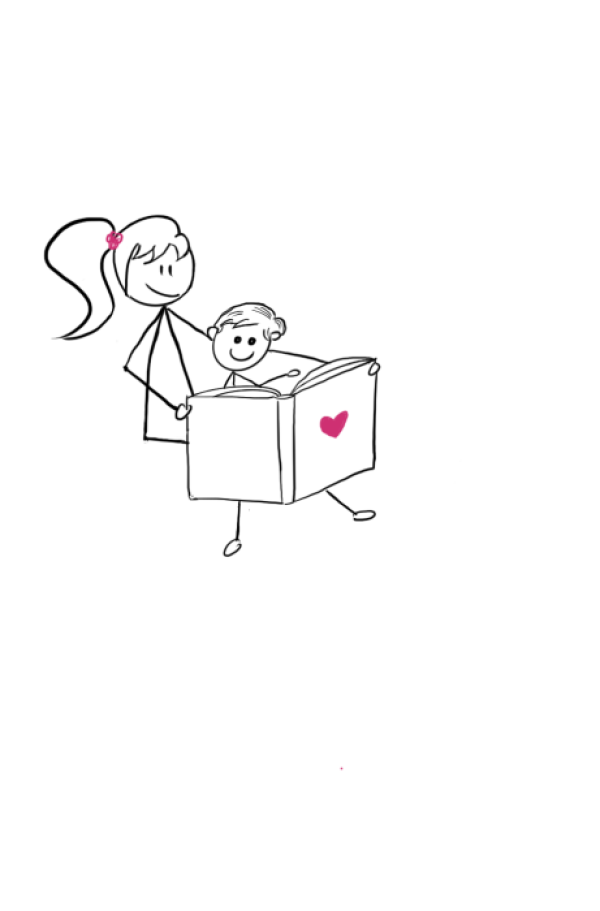
With a deep sigh, I entered the bedroom. Another Monday. Another explosive morning to survive.
Because the truth is, I’m afraid of kids with earsplitting voices and disarming energy.
While sipping my coffee, I skimmed through my notebook... the best parenting strategies scribbled down like a lifeline.
But guess what?
Nothing felt right.
I didn’t want to be the hysterical adult yelling through a closed door. I didn’t want to rely on harsh discipline or power struggles.
I wanted to empower my son, touch him with my words, and spark belief in himself.
So how could I create a smooth, connected morning and make our home the desert water hole my neurodiverse son craved?
Here are 3 empathy-based strategies that truly transformed our bond and helped me connect with my neurodiverse son.
1. Embrace an empathy-based mindset
I get it.
From navigating explosive behaviour to battling the worry and judgment of others, and the itty bitty from systems around us, embracing empathy can feel like the tip of the iceberg.
But the truth is, neurodiverse kids are often misjudged and mishandled.
For example, my son, AuADHD, struggles with sensory input and says, "It's hard to listen when you hear everything at once."
Those words sank deep into my heart.
So, what's the answer?
I try to remember that behind every meltdown, refusal, or shutdown is a need that hasn’t been met.
In her book, Out of Control, clinical psychologist Dr. Shefali Tsabari says:
“Dysfunctional behaviour in our children is always about unmet needs. Even when children engage in deception and outright lying, the root is unmet needs.”
That one sentence has been more valuable to me than any parenting manual. It’s shaped the way I show up for my son—not with control, but with compassion.
It also changed how I think.
The idea that my son does well if he wants to started to fall apart.
I now deeply believe, my son does well if he can.
That mindset shift influences how I speak, respond, and guide him, especially during challenging moments.
2. Identify problems with empathy
Every child is different.
But here’s what they all have in common: they’re often overwhelmed by expectations they don’t have the skills to meet yet.
And when those demands pile up, the behavior that erupts can feel shocking, defiant, or even scary.
But I’ve learned something: behavior is communication.
When my son hits an emotional wall, I try to pause. Instead of escalating, I take a breath or ten.
One day, he was spiralling and refusing to go to school. I could have argued. I almost did.
Instead, I sat beside him and said, “What’s going on? What do you need?”
After a long silence, he whispered that he was scared. A kid had laughed at him the day before. He thought everyone would laugh again.
And just like that, the resistance made sense.
I think about a story neurodiversity expert Chezzy Kennedy told.
It was about a boy named Henry who wouldn’t come into class. The teachers escalated. Threats were made. Then Henry threatened to set off the fire alarms.
But instead of pushing harder, Kennedy dropped to Henry’s level and asked him to guide her to a safe space.
He brought her to the medical room.
When she asked what he needed, Henry said he wanted to go home. His dog was at the vet, and he was terrified something had happened.
A whole crisis unraveled simply because no one had asked, “What do you need?”
That stuck with me.
Because when we focus more on what’s causing the behaviour, instead of just trying to squash the behaviour, we start seeing our kids more clearly.
And they feel it.
3. Be empathetic
It’s devastating to see how often punishment is still used in response to neurodiverse behavior—at home, in schools, and in society.
The stats are heartbreaking.
According to Lives in the Balance, 98,000 children in the U.S. are physically restrained and secluded each year. Another 92,000 are still corporally punished. The toll is even heavier on Black and LGBTQ+ children.
That’s why I’ve made a choice in our home.
I choose empathy. I choose collaboration.
Research shows that parents who cultivate empathy and proactively solve problems manage challenging behaviour more effectively and build lasting trust.
For me, the turning point was discovering the work of Dr. Ross W. Greene, founder of Lives in the Balance. His CPS (Collaborative & Proactive Solutions) model opened my eyes to a more compassionate path.
His books—The Explosive Child and Lost At School—aren’t just for teachers. They’re lifelines for parents like me.
He taught me to act as a mirror, not a hammer.
To help my child identify the problem and develop the skills he needs to communicate better.
Be the warm hug, the safe pause, the steady voice.
Helping My Son Thrive With Empathy
Some days still feel like a whirlwind.
Sometimes I lose my patience. Sometimes I feel like I’m failing.
But then, I remember what we’re building something rooted in empathy, not control.
A connection that’s stronger than the chaos.
A home that feels like water in the desert.
Because when my son knows I’m truly listening, truly seeing him, he blooms.
And I do, too.
Come on. Dare to change your home to the desert water hole your child craves.
And, let your empathy shine, sparkle, and glow.
Subscribe to Disability Tidbits newsletter
Get expert insights and practical tips that help you reach a wider audience—the disability community.
How To Create An Accessible Workplace For Blind People (And Boost An Inclusive Business Culture)

I know what you're thinking.
Why focus on accessibility for blind people when so many workplaces are already designed for people without disabilities?
When I started sharing insights about accessible workplaces for blind people on LinkedIn, I was blown away by the response.
People from all over the world started listening and, more importantly, taking action.
So, why should you care about creating an accessible workplace for blind people?
Let’s find out.
Creating a smooth workplace experience is like nurturing a friendship
When your friendship gets estranged, it starts to crack and break down. Talking to each other becomes harder. And, perhaps the friendship might even die.
Ioanna Maria Gkertsou, a clinical psychologist who's also a guide dog user, recommends being a safe space for your friend.
Open the lines of communication to reduce friction, and prevent frizzle.
When designing your workplace to be accessible for blind people, you do exactly the same.
First, you create a safe space.
You eliminate barriers and replace inaccessible facilities.
And then, you provide trustworthy information for a silky smooth working experience.
Lucy Edwards, a UK based blind broadcaster says:
"Businesses have to meet certain building regulations like doors opening outwards which is helpful for me and Molly because if it opened inward I might get Molly's paws trapped and that would be awful."
I know what you're thinking:
But, what if my business doesn't have a blind employee or blind customers using our offices?
According to a recent report from the International Agency for the Prevention of Blindness's Vision Atlas, Western Europe has 32.4 million blind people, and by 2050 the numbers are expected to rise to a whopping 49.7 million.
That's a lot of blind people who would feel delighted to use your accessible offices.
For the record, here's a table showing the growing numbers of people with blindness in Western Europe, North America, South East Asia, North Africa, and the Middle East from 2020 to 2050.
| Regions | 2020 | 2050 |
| Western Europe | 32.4 million | 49.7 million |
| North America | 18.2 million | 28.8 million |
| South East Asia | 94.7 million | 163.1 million |
| North Africa and Middle East | 53.8 million | 116.1 million |
Do you see how huge this is?
So, how can you design the faultlessly accessible offices that blind people so desperately desire?
Research and understand the needs of blind people
As Head of Guide Dog Mobility Services at Lara Guide Dog School, these were the kind of moments that made my job so rewarding.
So, when clients would ask me for support in creating awareness in their company, I knew it meant so much more than that.
I was just here to support awesome guide dog teams navigate their workplace environment.
I was also here to help their coworkers create a workspace that was actually inclusive, not just technically accessible.
I remember stepping into Barbara's office greeted by the rhythmic tapping of her guide dog's tail as it thumped against the floor, and the smell of freshly brewed coffee.
Then we'd listen to the team's perspective, and I'd walk them through some changes like smarter office layouts, tactile markers, and assistive tech that could make a huge difference.
The best part?
Seeing the “aha” moments when they realised accessibility isn’t just about compliance for one disabled person, it’s about making work better for everyone.
As I headed out, Brando gave me a nuzzle, the best kind of positive feedback I could ask for.
When you create an inclusive workplace with a blind person in mind, the most amazing thing in the world happens.
You open yourself up and gain an understanding of the needs of blind people.
This is important when you're designing for accessibility, and crucial if you're looking to create a disability-inclusive business culture.
So, get to know blind people.
Ask them about their preferences, and listen to their perspectives.
For now, here are ten features to get you started on creating accessible workplaces for blind people.
1. Use Braille description (tactile labels) for visual signs like the toilet door symbol, and warning signs like the fire alarm.
2. Provide audio assistance to navigate rooms.
3. Use contrasting colors for door handles and door frames.
4. Use appropriate lighting.
5. Use colour contrasting for walls and floors.
6. Use the correct level of contrast for surface fittings and stairs.
9. For toilets, clearly define the toilet roll dispenser and provide hand wipes for blind people to quickly clean their hands before touching their cane and finding the sink.
10. Create enough space inside or outside of rooms for guide dogs, and make sure doors open inward.
11. Provide assistive technology.
There you go.
The truth is, creating accessible workplaces doesn't have to feel like a chore that costs.
And the best part is, you'll create that delightful disability-inclusive culture your employees desire.
Make your inclusive business feel like a kind friend
It's true, as a business owner it's hard to neglect accessibility if you want to be inclusive.
And, integrating accessibility in your workplace is more than just offering accommodations.
It's about providing services, products, and an inclusive culture.
It's about creating a business that builds trust.
So go ahead, be a kind friend to blind people.
Design workplaces with blind people in mind, and show the world why you're a true, inclusive business leader.
Subscribe to Disability Tidbits newsletter
Get expert insights and practical tips that help you reach a wider audience—the disability community.

